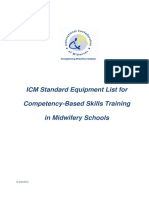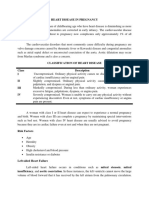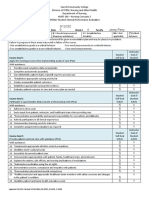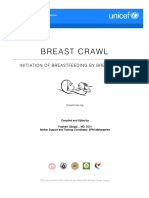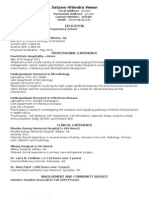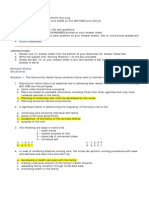Professional Documents
Culture Documents
Towards Adopting An 'Economic Impact' Approach in The Classification of The Burden of Oral Diseases The Case of The East African Community Countries
Original Title
Copyright
Available Formats
Share this document
Did you find this document useful?
Is this content inappropriate?
Report this DocumentCopyright:
Available Formats
Towards Adopting An 'Economic Impact' Approach in The Classification of The Burden of Oral Diseases The Case of The East African Community Countries
Copyright:
Available Formats
Volume 5, Issue 6, June – 2020 International Journal of Innovative Science and Research Technology
ISSN No:-2456-2165
Towards Adopting an `Economic Impact’ Approach
in the Classification of the Burden of Oral Diseases:
The Case of the East African Community Countries
Okemwa, kenneth.A1, Ruttoh ,simon. K2
School of Dentistry, College of Health Sciences, Moi University, Eldoret 4606 30100, Kenya.
School of Public Health, College of Health Sciences, Moi University, Eldoret 4606 30100, Kenya.
Abstract I. INTRODUCTION
Introduction Reporting the economic burden of oral diseases is
This commentary argues for a change in the way important to evaluate the societal relevance of preventing
we communicate the burden of dental diseases to policy and addressing oral diseases. In addition to treatment costs,
makers so that the economic impact of these diseases there are indirect costs to consider, mainly in terms of
can be more easily and realistically appreciated. productivity losses due to absenteeism from work. The
Specific reference to dental caries in the East African study published in 2015 on global economic burden of
Community countries (EAC) will be used to argue out dental disease suggests that the economic impact amounted
the case. to US$442 billion in 2010 in both direct and indirect costs,
corresponding to an average of 4.6% of global health
Methods expenditure. [1]
A literature review was done to tease out the
severity and prevalence of Dental caries in the EAC In resource constrained countries, competition for
countries. Using the average DMFT/dmft, the scarce national resources is such that priority would be
approximate cost which would be required to treat given to those areas in health perceived, through available
dental caries in each country was calculated. data, to be most needy. Measures of morbidity, severity and
mortality of diseases and conditions therefore play an
Results important role in decision making by policy makers.
The EAC countries are classified as having very
low severity of dental caries among 12 year olds and low The most commonly used measure of dental caries in
severity among adults aged 33-44 years. However the populations and individuals is the Decayed; Missing and
financial implication of treatment of dental caries for Filled teeth (DMFT) index for permanent teeth and the dft
each country is enormous. (decayed, filled teeth) index for primary teeth.
Conclusion These indices have been given an explanatory
Focus on DMFT alone to convey the burden of translation as follow:
dental caries may send wrong messages to policy
makers thus affecting oral health financing. DMFT TRANSLATION
Recommendations < 1.1 very low
A Caries Economic Burden (CEB) index is 1.2-2.5 low
proposed. This index would quantify the cost of caries 2.6---3.5 moderate
treatment in a country by multiplying a country’s > 3.5 high
average DMFT by the population and average cost of
treatment. This index will be dynamic and country For policy makers-who, more often than not, happen
specific. to be politicians- the terms ‘very low’ and ‘low’, ‘moderate
‘and “high’ are what will be teased out of the classification.
Keywords:- dental caries, DMFT, economic impact, East
African Community countries, , caries economic burden The implication of this is that, most likely, not much
index (CEB) priority will be given to dental health care in terms of
financial allocation in those countries with a lower rating
scale.
IJISRT20JUN282 www.ijisrt.com 215
Volume 5, Issue 6, June – 2020 International Journal of Innovative Science and Research Technology
ISSN No:-2456-2165
Perhaps then to remedy this scenario, as health care the provision of oral health care to their citizens either fully
professionals we need to be more ingenious in the way we or in a subsided format. They are therefore the focus of this
communicate the burden of oral diseases to policy makers. discussion
It is out of this conviction that this concept paper The EAC scenario
argues for a classification of the burden of dental caries According to the World Health Organization ( WHO)
based on an ‘economic impact approach’. This global caries map, the East African community countries
classification would easily bring out the financial (EAC) are classified as having very low or low levels of
implications of dental disease to a country; and perhaps dental caries among 12 year olds based on the DMFT/dft
impress upon the policy makers the need for adequate oral indices (2014 data) [2].A similar map for adults classifies
health care financing. the severity among adults aged 33-44 years as low.
The countries of the East African community (Kenya, Table 1 below is an extract from the WHO global oral
Uganda, Tanzania, Burundi, and Rwanda) will be used in health database on DMFT for 12-year-olds (2015) [3].
this discussion. The governments of these countries fund
Country Year DMFT classification
Burundi 1987-1988 1.0 Very low
Kenya 2015 0.4 Very low
Rwanda 1993 0.3 Very low
Tanzania 2004 0.3 Very low
Uganda 2008 0.7 Very low
Table 1:- DMFT information -WHO
This puts across the message that dental caries is very of treatment like root canal treatment and crowns will not
low in these countries; and from a policy point of view this be considered for the purpose of this paper. This is because.
may not attract much concern. In 2015 the ministry of health in Kenya undertook the first
national oral health survey which indicate an overall
Cost translation of DMFT for EAC and implication on DMFT for adults of 0.72 and an overall DMFT/dft of 0.72
country health budgets for children aged 5,12 and 15 years respectively 5.
The Kenya Medical Practitioners and Dentist Board
(KMPDB) has guidelines on the cost of dental treatment in A similar survey done in Rwanda in 2018 indicated
Kenya [4] .Though these apply to private practice it is dft of 1.69 and DMFT of 3.19 6
assumed that these constitute the actual cost even in the
government hospitals since the government covers the
subsidised cost through equipment supply, remuneration Since this is the data most likely to be considered by
and training of health care workers. policy makers it will be used to argue the concept in this
discussion for Kenya and Rwanda. The other 3 countries
Online search did not elicit similar cost guidelines don’t seem to have done national oral health surveys
from the other 4 countries. The KMPDB fee guideline will therefore the figures available from WHO will be used.
therefore be used as the average cost across the EAC
countries. For Tanzania the average of the dft and DMFT from
the study done by Carneiro et al in 2012 will be used since
For resource constrained countries, it is most likely this is the latest information which seems to be available
that the treatment prescribed for dental caries, at least at its online. The dft from this study was 0.95 while the DMFT
symptomatic stage, is extraction or filling. The other was 1.26 thus giving an average of 1.17
treatment options like endondotic treatment and crowns
tend to be out of reach for most people. As a result, the Latest study published from Uganda in 2015 gave an
costs of simple extraction and fillings will be used in this overall dft of 0.73 and DMFT of 4.71. The average of these
discussion. values (2.72) will be used 8.
For the purposes of this paper the average cost of There are no current studies which have been done in
treatment of a decayed tooth will be taken as the average of Burundi therefore the figure available on the WHO website
the sum cost of an extraction (ksh 3000) and that of a will be used.
filling (kshs 4000). The lower cost for each procedure has
been taken. Therefore the average cost for purposes of this Based on these figures, Table 2 below illustrates the
write-up will be KSh 3500 -about 35 United States dollars potential financial cost- equivalent for treatment which
(USD) currently. The cost of other more expensive forms each country would incur.
IJISRT20JUN282 www.ijisrt.com 216
Volume 5, Issue 6, June – 2020 International Journal of Innovative Science and Research Technology
ISSN No:-2456-2165
Country averageDMFT/dft Population Gross number of App cost of treatment Budget allocation for
(000,000) Carious teeth needed (millions of US health per country
(2017) 9 Dollars) (million US dollars)
2017-2018
Kenya O.73 49.70 32,375,500 1133 1236 10
Rwanda 2.94 12.21 35,897,400 1256 202 M 11
Tanzania 1.1 57.31 63,041,000 2206
961M 12
Uganda 2.72 42.86 116579200 1095 493 M13
Burundi 1.0 10.86 10,860,000 380 9114
Gross number of carious teeth=DMF/df X population: cost=number of carious teeth X USD 35:
Table 2:- Country specific DMFT/dft cost implication
It is apparent that the amount of money which would Weakness of the discussion
be required to treat this “low” occurrence of dental caries in The definition of economic burden in our discussion is
these countries is quite substantial- surpassing the total purely based on the direct cost of treatment and excludes
budgetary allocation for health in all the countries. In the indirect costs which are used in already established
Kenya alone this would add up to USD 113 MILLION; methodologies.
almost equivalent to the total budgetary allocation for
Health at National and county government levels for the Our discussion is based on an assumption that the D
year 2016/2017. Treatment costs for Rwanda, Tanzania, in the DMFT requires filling or extraction. This of course is
Uganda and Burundi would be 6, 2.3, 2.2 and 4 times more another weakness of our debate.
than those countries’ health budgets respectively.
The suggested CEB is very simplistic in nature and
Suggested approach has not taken into consideration the indirect costs of dental
Based on the most recent surveys in a country, a table caries treatment. This of course is an obvious weakness
can be formulated where the DMFT and dft values for that which should always be stated. Given the complexity of
country are translated into an economic burden equivalent calculating indirect cost of illness- and the fact that this is
for that country using the formula: especially so for dental caries, the authors believe that the
CEB suggested will be a useful and quick appraisal of a
DMFT x AVERAGE COST OF TREATMENT IN country’s dental caries economic burden based on
USD x POPULATION= total cost to country needed for treatment needs
dental caries treatment in USD
II. CONCLUSION
Caries Economic Burden (CEB) index= total cost
above/1000000 This discussion does not aim to come up with a
The CEB for the East African countries ,as derived comprehensive methodology of calculating cost of illness.
from table 3, would therefore be 1133, 1256, 2206 , 1095 The CEB suggested rides on the already routine and
and 380 for Kenya, Rwanda, Tanzania , Uganda and traditional DMFT classification. It is, so to speak, a
Burundi, respectively. conversion of a country’s dental caries severity into a cost
value.
The CEB X 1000000 will be the total cost, in United
State dollars, which a country would need to treat its It is hoped that this paper will trigger off further
population of dental caries in the year under consideration. discussions and debate on the suggestions proposed.
Modifications on the proposed index, or indeed an entirely
Characteristics of this proposed index include new one, will hopefully arise from this initiative. As earlier
Flexibility and country specificity so as to take into stated, sometimes scientific communication may not
consideration the economic status for each country. This register in the minds of policy makers with the desired
will be in line with with the FDI recommendations in impact, especially at the crucial level of resource allocation.
the GLOBAL ORAL HEALTH GOALS 2020 where More often than not these are politicians; therefore, it is
the motto: 'think globally act locally’’ is advocated(5) important that we change the way we communicate to
15
them. This is especially true for resource constrained
Dynamism which takes into consideration the projected developing countries like the East African Community
yearly increase in population of that country. This countries used in this concept paper.
means that it will be reviewed periodically (annually,
biannually or otherwise) depending on the actual or This should be a dynamic index which is reviewed
projected population changes). Dynamism would also periodically (annually, biannual or otherwise) depending on
mean a recalculation wherever there is new data from projected population changes. Continuous country wide
research surveys of DMFT will be an important component of the
index.
IJISRT20JUN282 www.ijisrt.com 217
Volume 5, Issue 6, June – 2020 International Journal of Innovative Science and Research Technology
ISSN No:-2456-2165
This suggested classification could also play an https://profiles.uonbi.ac.ke/gathece/files/kenya_nation
important role in arguing for resource allocation for al_oral_health_survey_report2015.pdf> . (
primary oral health care: If policy makers see what can be Accessed on 21st Nov 2019)
saved by investing in disease prevention then they are more [6]. Morgan JP, Isyagi M, Ntaganira J, et al. Building oral
likely to support primary healthcare budgets which, in the health research infrastructure: the first national oral
long term, are lower than curative budgets. health survey of Rwanda. Glob Health Action.
2018;11(1):1477249.
Abbreviations . doi: 10.1080/16549716.2018.1477249
WHO-World Health Organization [7]. Carneiro LC, Kabulwa MN. Dental Caries, and
DMFT-Decayed, Missing, Filled Teeth index Supragingival Plaque and Calculus among Students,
dft- decayed, filled teeth index Tanga, Tanzania. ISRN Dent. 2012;2012:245296.
CEB-Caries Economic Burden index (proposed) doi: 10.5402/2012/245296.
EAC- East African Community [8]. Kutesa A, Kasangaki A, Nkamba M, et al. Prevalence
and factors associated with dental caries among
Declarations children and adults in selected districts in Uganda. Afr
Health Sci. 2015;15(4):1302-7.
Funding doi: 10.4314/ahs.v15i4.33
No funding was obtained for this study [9]. World Bank 2017: world population estimates
https://data.worldbank.org/indicator/SP.POP.TOTL?lo
Author’s contributions cations=NG-BI&name_desc=false
KO came up with the concept and wrote the first draft [10]. Republic of Kenya. National and County Health
of the manuscript. RS contributed to the manuscript Budget Analysis FY 2016/2017.
drafting and modification. Both authors read and approved http://www.healthpolicyplus.com/ns/pubs/6138-
the final manuscript. 6239_FINALNationalandCountyHealthBudgetAnalys
is.pdf. (Accessed on 14th Feb 2019)
Ethics approval and consent to participate [11]. Ministry of Finance and Economic Planning, Rwanda.
Not Applicable. This is a commentary and did not The National Budget Citizens’ Guide for 2018/2019.
involve any research therefore a review by the institutional http://www.minecofin.gov.rw/fileadmin/templates/doc
ethics body was not necessary. uments/Fiscal_Decentralisation_Unit/Budget_Citizen
_Guide/2018-
Consent for Publication 2019/2018_19_Final_Citizen_Guide_to_the_Budget_-
Not applicable _English.pdf (Accessed on 2nd Feb 2019)
[12]. Lee B, Tarimo K. Analysis of the government of
Competing interests Tanzania's budget allocation to the health sector for
The authors declare that they have no competing fiscal year 2017/18'. HP+ policy brief. Washington,
interests DC: Health Policy Plus.
http://www.healthpolicyplus.com/ns/pubs/7183-
REFERENCES 7323_TanzaniaBudgetAllocationHealthSectorBrief.pd
f (accessed on 21st Nov 1019)
[1]. Listl S, Galloway J, Mossey PA, et al. Global [13]. Moses O. The 2017/18 Uganda budget -what is in for
Economic Impact of Dental Diseases. J Dent Res. the poorest and most vulnerable. Development
2015; 94(10):1355-61. initiatives. http://devinit.org/wp-
DOI:10.1177/0022034515602879 content/uploads/2017/11/the-2017-18-Uganda-
[2]. Malmo University. Global caries map for 12 year budget_briefing-paper.pdf. (Accessed on 25th Jan
olds. 2014 https://www.mah.se/CAPP/Country-Oral- 2019.)
Health-Profiles/According-to-WHO-Regions/Global- [14]. UNICEF. The 2017 State Budget, Burundi.
caries-map-2013--2014/ ( Accessed 21st Nov 2019) https://www.unicef.org/esa/sites/unicef.org.esa/files/2
[3]. Malmo University. Oral health database. 018-09/UNICEF-Burundi-2017-National-Budget-
https://www.mah.se/CAPP/Country-Oral-Health- Brief.pdf (accessed on 25th Jan 2019)
Profiles/AFRO/. (Accessed 21st Nov 2019) [15]. Hobdell M, Petersen PE, Clarkson J, Johnson N.
[4]. Government of Kenya, Ministry of Health, Kenya Global goals for oral health 2020. Int Dent J.
Medical Practitioners and Dentist Board. FEES 2003;53(5):285-8. DOI:10.1111/j.1875-
GUIDELINES FOR MEDICAL & DENTAL 595x.2003.tb00761.x
RACTITIONERS. 2016
http://medicalboard.co.ke/resources/Medical_and_De
ntal_Professional_Fees_2016.pdf (Accessed on 1st
Nov 2019)
[5]. Government of Kenya, Ministry of Health: KENYA
NATIONAL ORAL HEALTH SURVEY REPORT
2015.
IJISRT20JUN282 www.ijisrt.com 218
You might also like
- The Subtle Art of Not Giving a F*ck: A Counterintuitive Approach to Living a Good LifeFrom EverandThe Subtle Art of Not Giving a F*ck: A Counterintuitive Approach to Living a Good LifeRating: 4 out of 5 stars4/5 (5794)
- The Gifts of Imperfection: Let Go of Who You Think You're Supposed to Be and Embrace Who You AreFrom EverandThe Gifts of Imperfection: Let Go of Who You Think You're Supposed to Be and Embrace Who You AreRating: 4 out of 5 stars4/5 (1090)
- Never Split the Difference: Negotiating As If Your Life Depended On ItFrom EverandNever Split the Difference: Negotiating As If Your Life Depended On ItRating: 4.5 out of 5 stars4.5/5 (838)
- Hidden Figures: The American Dream and the Untold Story of the Black Women Mathematicians Who Helped Win the Space RaceFrom EverandHidden Figures: The American Dream and the Untold Story of the Black Women Mathematicians Who Helped Win the Space RaceRating: 4 out of 5 stars4/5 (890)
- Grit: The Power of Passion and PerseveranceFrom EverandGrit: The Power of Passion and PerseveranceRating: 4 out of 5 stars4/5 (587)
- Shoe Dog: A Memoir by the Creator of NikeFrom EverandShoe Dog: A Memoir by the Creator of NikeRating: 4.5 out of 5 stars4.5/5 (537)
- Elon Musk: Tesla, SpaceX, and the Quest for a Fantastic FutureFrom EverandElon Musk: Tesla, SpaceX, and the Quest for a Fantastic FutureRating: 4.5 out of 5 stars4.5/5 (474)
- The Hard Thing About Hard Things: Building a Business When There Are No Easy AnswersFrom EverandThe Hard Thing About Hard Things: Building a Business When There Are No Easy AnswersRating: 4.5 out of 5 stars4.5/5 (344)
- Her Body and Other Parties: StoriesFrom EverandHer Body and Other Parties: StoriesRating: 4 out of 5 stars4/5 (821)
- The Sympathizer: A Novel (Pulitzer Prize for Fiction)From EverandThe Sympathizer: A Novel (Pulitzer Prize for Fiction)Rating: 4.5 out of 5 stars4.5/5 (119)
- The Emperor of All Maladies: A Biography of CancerFrom EverandThe Emperor of All Maladies: A Biography of CancerRating: 4.5 out of 5 stars4.5/5 (271)
- The Little Book of Hygge: Danish Secrets to Happy LivingFrom EverandThe Little Book of Hygge: Danish Secrets to Happy LivingRating: 3.5 out of 5 stars3.5/5 (399)
- The World Is Flat 3.0: A Brief History of the Twenty-first CenturyFrom EverandThe World Is Flat 3.0: A Brief History of the Twenty-first CenturyRating: 3.5 out of 5 stars3.5/5 (2219)
- The Yellow House: A Memoir (2019 National Book Award Winner)From EverandThe Yellow House: A Memoir (2019 National Book Award Winner)Rating: 4 out of 5 stars4/5 (98)
- Devil in the Grove: Thurgood Marshall, the Groveland Boys, and the Dawn of a New AmericaFrom EverandDevil in the Grove: Thurgood Marshall, the Groveland Boys, and the Dawn of a New AmericaRating: 4.5 out of 5 stars4.5/5 (265)
- A Heartbreaking Work Of Staggering Genius: A Memoir Based on a True StoryFrom EverandA Heartbreaking Work Of Staggering Genius: A Memoir Based on a True StoryRating: 3.5 out of 5 stars3.5/5 (231)
- Team of Rivals: The Political Genius of Abraham LincolnFrom EverandTeam of Rivals: The Political Genius of Abraham LincolnRating: 4.5 out of 5 stars4.5/5 (234)
- On Fire: The (Burning) Case for a Green New DealFrom EverandOn Fire: The (Burning) Case for a Green New DealRating: 4 out of 5 stars4/5 (73)
- The Unwinding: An Inner History of the New AmericaFrom EverandThe Unwinding: An Inner History of the New AmericaRating: 4 out of 5 stars4/5 (45)
- Nursing Concept MapDocument3 pagesNursing Concept MapSheNo ratings yet
- Automatic Power Factor ControllerDocument4 pagesAutomatic Power Factor ControllerInternational Journal of Innovative Science and Research TechnologyNo ratings yet
- Intelligent Engines: Revolutionizing Manufacturing and Supply Chains with AIDocument14 pagesIntelligent Engines: Revolutionizing Manufacturing and Supply Chains with AIInternational Journal of Innovative Science and Research TechnologyNo ratings yet
- Navigating Digitalization: AHP Insights for SMEs' Strategic TransformationDocument11 pagesNavigating Digitalization: AHP Insights for SMEs' Strategic TransformationInternational Journal of Innovative Science and Research TechnologyNo ratings yet
- A Review: Pink Eye Outbreak in IndiaDocument3 pagesA Review: Pink Eye Outbreak in IndiaInternational Journal of Innovative Science and Research TechnologyNo ratings yet
- Teachers' Perceptions about Distributed Leadership Practices in South Asia: A Case Study on Academic Activities in Government Colleges of BangladeshDocument7 pagesTeachers' Perceptions about Distributed Leadership Practices in South Asia: A Case Study on Academic Activities in Government Colleges of BangladeshInternational Journal of Innovative Science and Research TechnologyNo ratings yet
- Securing Document Exchange with Blockchain Technology: A New Paradigm for Information SharingDocument4 pagesSecuring Document Exchange with Blockchain Technology: A New Paradigm for Information SharingInternational Journal of Innovative Science and Research TechnologyNo ratings yet
- Mobile Distractions among Adolescents: Impact on Learning in the Aftermath of COVID-19 in IndiaDocument2 pagesMobile Distractions among Adolescents: Impact on Learning in the Aftermath of COVID-19 in IndiaInternational Journal of Innovative Science and Research TechnologyNo ratings yet
- Studying the Situation and Proposing Some Basic Solutions to Improve Psychological Harmony Between Managerial Staff and Students of Medical Universities in Hanoi AreaDocument5 pagesStudying the Situation and Proposing Some Basic Solutions to Improve Psychological Harmony Between Managerial Staff and Students of Medical Universities in Hanoi AreaInternational Journal of Innovative Science and Research TechnologyNo ratings yet
- Review of Biomechanics in Footwear Design and Development: An Exploration of Key Concepts and InnovationsDocument5 pagesReview of Biomechanics in Footwear Design and Development: An Exploration of Key Concepts and InnovationsInternational Journal of Innovative Science and Research TechnologyNo ratings yet
- Perceived Impact of Active Pedagogy in Medical Students' Learning at the Faculty of Medicine and Pharmacy of CasablancaDocument5 pagesPerceived Impact of Active Pedagogy in Medical Students' Learning at the Faculty of Medicine and Pharmacy of CasablancaInternational Journal of Innovative Science and Research TechnologyNo ratings yet
- Formation of New Technology in Automated Highway System in Peripheral HighwayDocument6 pagesFormation of New Technology in Automated Highway System in Peripheral HighwayInternational Journal of Innovative Science and Research TechnologyNo ratings yet
- Natural Peel-Off Mask Formulation and EvaluationDocument6 pagesNatural Peel-Off Mask Formulation and EvaluationInternational Journal of Innovative Science and Research TechnologyNo ratings yet
- Drug Dosage Control System Using Reinforcement LearningDocument8 pagesDrug Dosage Control System Using Reinforcement LearningInternational Journal of Innovative Science and Research TechnologyNo ratings yet
- The Effect of Time Variables as Predictors of Senior Secondary School Students' Mathematical Performance Department of Mathematics Education Freetown PolytechnicDocument7 pagesThe Effect of Time Variables as Predictors of Senior Secondary School Students' Mathematical Performance Department of Mathematics Education Freetown PolytechnicInternational Journal of Innovative Science and Research TechnologyNo ratings yet
- Enhancing the Strength of Concrete by Using Human Hairs as a FiberDocument3 pagesEnhancing the Strength of Concrete by Using Human Hairs as a FiberInternational Journal of Innovative Science and Research TechnologyNo ratings yet
- Supply Chain 5.0: A Comprehensive Literature Review on Implications, Applications and ChallengesDocument11 pagesSupply Chain 5.0: A Comprehensive Literature Review on Implications, Applications and ChallengesInternational Journal of Innovative Science and Research TechnologyNo ratings yet
- Advancing Opthalmic Diagnostics: U-Net for Retinal Blood Vessel SegmentationDocument8 pagesAdvancing Opthalmic Diagnostics: U-Net for Retinal Blood Vessel SegmentationInternational Journal of Innovative Science and Research TechnologyNo ratings yet
- The Making of Self-Disposing Contactless Motion-Activated Trash Bin Using Ultrasonic SensorsDocument7 pagesThe Making of Self-Disposing Contactless Motion-Activated Trash Bin Using Ultrasonic SensorsInternational Journal of Innovative Science and Research TechnologyNo ratings yet
- Placement Application for Department of Commerce with Computer Applications (Navigator)Document7 pagesPlacement Application for Department of Commerce with Computer Applications (Navigator)International Journal of Innovative Science and Research TechnologyNo ratings yet
- REDLINE– An Application on Blood ManagementDocument5 pagesREDLINE– An Application on Blood ManagementInternational Journal of Innovative Science and Research TechnologyNo ratings yet
- Beyond Shelters: A Gendered Approach to Disaster Preparedness and Resilience in Urban CentersDocument6 pagesBeyond Shelters: A Gendered Approach to Disaster Preparedness and Resilience in Urban CentersInternational Journal of Innovative Science and Research TechnologyNo ratings yet
- Exploring the Clinical Characteristics, Chromosomal Analysis, and Emotional and Social Considerations in Parents of Children with Down SyndromeDocument8 pagesExploring the Clinical Characteristics, Chromosomal Analysis, and Emotional and Social Considerations in Parents of Children with Down SyndromeInternational Journal of Innovative Science and Research TechnologyNo ratings yet
- Handling Disruptive Behaviors of Students in San Jose National High SchoolDocument5 pagesHandling Disruptive Behaviors of Students in San Jose National High SchoolInternational Journal of Innovative Science and Research TechnologyNo ratings yet
- Safety, Analgesic, and Anti-Inflammatory Effects of Aqueous and Methanolic Leaf Extracts of Hypericum revolutum subsp. kenienseDocument11 pagesSafety, Analgesic, and Anti-Inflammatory Effects of Aqueous and Methanolic Leaf Extracts of Hypericum revolutum subsp. kenienseInternational Journal of Innovative Science and Research TechnologyNo ratings yet
- A Curious Case of QuadriplegiaDocument4 pagesA Curious Case of QuadriplegiaInternational Journal of Innovative Science and Research TechnologyNo ratings yet
- A Knowledg Graph Model for e-GovernmentDocument5 pagesA Knowledg Graph Model for e-GovernmentInternational Journal of Innovative Science and Research TechnologyNo ratings yet
- Analysis of Financial Ratios that Relate to Market Value of Listed Companies that have Announced the Results of their Sustainable Stock Assessment, SET ESG Ratings 2023Document10 pagesAnalysis of Financial Ratios that Relate to Market Value of Listed Companies that have Announced the Results of their Sustainable Stock Assessment, SET ESG Ratings 2023International Journal of Innovative Science and Research TechnologyNo ratings yet
- Pdf to Voice by Using Deep LearningDocument5 pagesPdf to Voice by Using Deep LearningInternational Journal of Innovative Science and Research TechnologyNo ratings yet
- Adoption of International Public Sector Accounting Standards and Quality of Financial Reporting in National Government Agricultural Sector Entities, KenyaDocument12 pagesAdoption of International Public Sector Accounting Standards and Quality of Financial Reporting in National Government Agricultural Sector Entities, KenyaInternational Journal of Innovative Science and Research TechnologyNo ratings yet
- Fruit of the Pomegranate (Punica granatum) Plant: Nutrients, Phytochemical Composition and Antioxidant Activity of Fresh and Dried FruitsDocument6 pagesFruit of the Pomegranate (Punica granatum) Plant: Nutrients, Phytochemical Composition and Antioxidant Activity of Fresh and Dried FruitsInternational Journal of Innovative Science and Research TechnologyNo ratings yet
- Pedo Revision For Part 1Document17 pagesPedo Revision For Part 1asadNo ratings yet
- Covid Response ST Josephs School - TeachersDocument2 pagesCovid Response ST Josephs School - Teachersapi-70996446No ratings yet
- John Williamson and The Terrifying Results of The Medical Practice Information Demonstration ProjectDocument8 pagesJohn Williamson and The Terrifying Results of The Medical Practice Information Demonstration ProjectFrancisco LazoNo ratings yet
- MODULE 1 Spear 212 EditedDocument25 pagesMODULE 1 Spear 212 EditedJeriel Baton SeguidoNo ratings yet
- TB Drug StudyDocument15 pagesTB Drug StudyKaloy KamaoNo ratings yet
- Reaction PaperDocument2 pagesReaction PaperSherylou Kumo SurioNo ratings yet
- ICM Standard List For Competency-Based Skills TrainingDocument40 pagesICM Standard List For Competency-Based Skills TrainingRima SartikaNo ratings yet
- ScheduleDocument52 pagesSchedulerohitNo ratings yet
- DBM-DOH jc2022-0002Document18 pagesDBM-DOH jc2022-0002Drop ThatNo ratings yet
- Uses of Water As Therapeutic AgentDocument3 pagesUses of Water As Therapeutic AgentJake ArizapaNo ratings yet
- The Tuskegee Syphilis Experiment: Carolinak12@Unc - EduDocument12 pagesThe Tuskegee Syphilis Experiment: Carolinak12@Unc - EdufirdausNo ratings yet
- Heart Disease in PregnancyDocument5 pagesHeart Disease in PregnancyAngeliqueNo ratings yet
- Emma D'epagnier 3/12/202 0 4 Jenny PerryDocument3 pagesEmma D'epagnier 3/12/202 0 4 Jenny PerryEmma d'EpagnierNo ratings yet
- Comprehensive Cancer Care CenterDocument40 pagesComprehensive Cancer Care CenterKINJALNo ratings yet
- Chemical Hazards Safety GuideDocument6 pagesChemical Hazards Safety GuideLeanne BarnettNo ratings yet
- Immunology and Hypersensitivity: Central Tolerance, Peripheral Tolerance, Types of Hypersensitivity and Autoimmune DiseasesDocument7 pagesImmunology and Hypersensitivity: Central Tolerance, Peripheral Tolerance, Types of Hypersensitivity and Autoimmune DiseasesLianneRaoNo ratings yet
- Detailed Lesson Plan in Mapeh 8 JoanneDocument9 pagesDetailed Lesson Plan in Mapeh 8 JoanneLANI JOY TABAMONo ratings yet
- Breastcrawl PDFDocument41 pagesBreastcrawl PDFFayrouz EssawiNo ratings yet
- Practical Evaluation Format OBGDocument5 pagesPractical Evaluation Format OBGvineelainjetyNo ratings yet
- Adhereencia Al TX NTDocument8 pagesAdhereencia Al TX NTLibe SangNo ratings yet
- My C.V.Document2 pagesMy C.V.Saty VeeanNo ratings yet
- Russell BlaylockDocument3 pagesRussell BlaylockFer TenerifeNo ratings yet
- Limitations in Forensic Odontology: Eview RticleDocument3 pagesLimitations in Forensic Odontology: Eview RticleCikw KuzhaNo ratings yet
- Ophthalmology PDFDocument28 pagesOphthalmology PDFKukuh Rizwido PrasetyoNo ratings yet
- Tuvalu Standard Treatment GuidelinesDocument401 pagesTuvalu Standard Treatment GuidelinesportosinNo ratings yet
- Code Alert SystemDocument9 pagesCode Alert SystemSam Tagarda100% (1)
- Pediatric Nursing Masters ThesisDocument6 pagesPediatric Nursing Masters Thesisnelowow1vut3100% (1)
- Answer Key EXAM DRILL 1 - Community Health Nursing Nursing Practice Ii - CHN and Care of The Mother and ChildDocument11 pagesAnswer Key EXAM DRILL 1 - Community Health Nursing Nursing Practice Ii - CHN and Care of The Mother and Childbetiful100% (5)
- Fall Prevention Using TelemonitoringDocument14 pagesFall Prevention Using Telemonitoringapi-458433381No ratings yet














































































